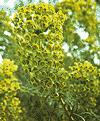- spurge
-
/sperrj/, n.any of numerous plants of the genus Euphorbia, having a milky juice and flowers with no petals or sepals. Cf. spurge family.[1350-1400; ME < MF espurge, n. deriv. of espurgier to cleanse < L expurgare. See EX-1, PURGE]
* * *
It takes its common name from a group of annual herbs used as purgatives, or spurges. Many spurges are important as ornamentals or as sources of drugs; many others are weeds. One of the best-known is the poinsettia. Euphorbia is part of the family Euphorbiaceae, which contains about 7,500 species of flowering annual and perennial herbs and woody shrubs or trees in 275 genera; most are found in temperate and tropical regions. Flowers usually lack petals; those of Euphorbia are borne in cup-shaped clusters. The fruit is a capsule. Leaves are usually simple. The stems of many species contain a milky latex. In addition to Euphorbia, economically important family members include the castor-oil plant, croton, cassava, and rubber tree. Spurge (Euphorbia venata)Valerie Finnis
Spurge (Euphorbia venata)Valerie Finnis* * *
▪ plant(Euphorbia), one of the largest flowering-plant genera, with 2,420 species, many of which are important to man as ornamentals, sources of drugs, or as weeds. The genus takes its common name from a group of annual herbs used as purgatives, or spurges, mainly the 1-metre- (3-foot-) tall European E. lathyris, seeds of which were once used for their laxative effect. The diverse, worldwide genus includes many species in arid parts of Africa and India that resemble cactus plants. Unlike cacti, euphorbias have a milky sap. Euphorbia plants vary from flat, creeping herbs—such as the weedy North American prostrate spurge (E. supine), which grows out of sidewalk cracks—to shrubs and trees. They have one female flower consisting of a single female reproductive structure, the pistil, surrounded by numerous male flowers of one stamen each. All these reduced flowers are enclosed in a cup-shaped, leaflike structure with five lobes and a gland on each, called a cyathium. Fruits are explosive, three-seeded capsules.The cactus-like kinds include spined, succulent (fleshy), and angled 15-m-tall trees such as E. candelabrum and E. nyikae from East Africa; spined and angled succulent shrubs, 6 m tall, such as E. grandicornis from southern Africa and E. lactea from the East Indies, both of which are grown as hedges in areas with a mild climate.Succulent but unthorned and with upright, 6-m, fingerlike, much-branched stems is milkbush (E. tirucalli) from India, used in Africa and many tropical places as a hedge for huts or cattle enclosures. Wax plant (E. antisyphilitica), from Mexico, has similar but unbranched, rodlike, gray-green, mostly naked, 1-m stems from the surface of which comes an important wax used for polishes, candles, lubricants, and paper waterproofing.The somewhat climbing, thorned, leafy, woody-stemmed crown of thorns (E. milii or E. splendens) from Madagascar is a popular houseplant in temperate areas and a good source of colour in tropical gardens.What is probably the most appreciated of the tropical euphorbias is the poinsettia from southern Mexico and Guatemala, which has scarlet bracts (leaflike structures attached just below flowers) and is associated with Christmas. Another species associated with Christmas in southern Mexico and Central America, where it is native, is the shrub pascuita (E. leucocephala), 1.5 to 4 m tall, which is covered much of the winter with a mist of small, white bracts. In some varieties the leaves are dark red. The scarlet plume (E. fulgens), from Mexico, a 90-centimetre- (3-foot-) tall shrub with slender stems and scarlet bract clusters, is sometimes grown as a pot plant and in mild-winter areas as a garden shrub.Perennial ornamentals of temperate climes include: cypress spurge (E. cyparissias), from Europe, a globe-shaped plant with needlelike foliage that is covered with golden bracts in spring; E. venata or E. wulfenii, from Europe, a plant, 0.9 to 1.2 m tall, with greenish yellow heads on bluish foliage; cushion spurge (E. epithymoides), from Europe, a 30.5-cm globe of gold to chartreuse that blooms in spring; E. characias, a 0.9- to 1.2-m-tall European plant with sulfur-yellow bracts in summer; and E. griffithii, from the Himalayas, the fireglow variety of which has fire-orange heads in early summer.Annual ornamentals include snow-on-the-mountain (E. marginata), native in the North American west; and many varieties of fire-on-the-mountain (E. heterophylla), from the eastern and central United States to Peru, with red-marked, poinsettia-like green bracts and leaves of varied shape on 90-centimetre- (35-inch-) tall plants.Important as weeds are flowering spurge (E. corollata), of the middle and eastern United States; the leafy spurge (E. escula), naturalized from Europe in the northern United States and adjacent Canada; spotted spurge (E. maculata); prostrate spurge and the related European petty spurge (E. peplus); and sun spurge (E. helioscopia).Some botanists have divided the euphorbias into various genera, including Chamaesyce, Poinsettia, Tithymalus, Tithymalopsis, and Dichrophyllum.* * *
Universalium. 2010.
